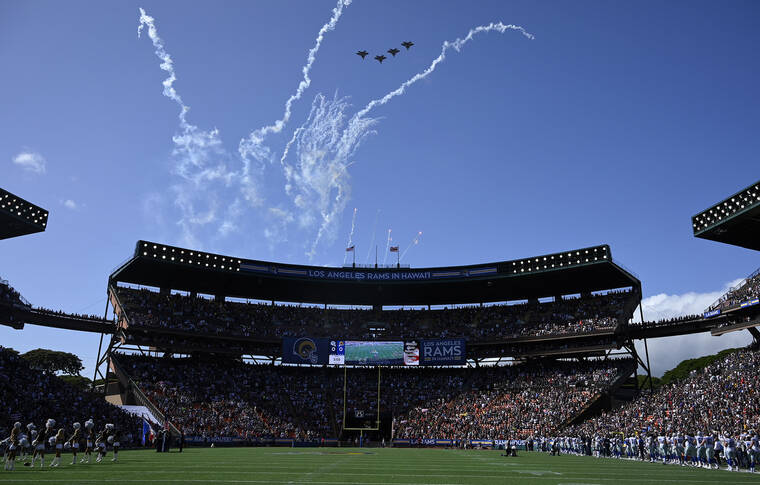There was plenty of misguided finger-pointing when only 7,646 — 49.9% of seating capacity — went through the Ching Complex turnstiles for last Saturday’s football game between Hawaii and Albany.
Blame it on the rain? Maybe, except rain in Manoa is as rare as gridlock at the Punahou off ramp.
Marketing? UH had a pregame concert, brought back three former Rainbow Warriors as schmooze bait, and gave fans posters, player cards and clear plastic bags to hold the player cards and personal items.
The Warriors’ 0-2 start? The Warriors have been a fan-accommodating team, meeting requests for a run-and-shoot offense with big-play potential, a high-emotion defense, and a head coach who views almost every spot as four-down territory. Plus, it was essentially guaranteed-win night. The Warriors had not lost to an FCS opponent since Sept. 9, 2000 — exactly 23 years earlier.
Critics could not even pin this on pay-per-view. The previous week, factoring the 2,000 unticketed fans who entered before the intermission, there was a near-capacity crowd for the home opener against Stanford. And that game was free of charge on national television.
Hawaii is a no-fault state, but when it comes to UH’s attendance woes, the fault lies with lawmakers and Aloha Stadium’s past and current leaders. They allowed the stadium to deteriorate in phases — the once-movable stands unable to budge, leaving the facility frozen in a football configuration, and then the malignant rust causing holes in the aisles. As we all know, self-condemning of Aloha Stadium in December 2020 forced the Warriors to relocate their home football games to the problematic Ching Complex.
Despite UH’s best efforts and the installation of rows of seat backs, there is just not enough knee room for spectators in the bleachers. The long wait for beer was fixable; the equivalent of back-of-the-plane middle seats needs a solution.
The thing is, as UH fans make adjustments with the promise of a replacement stadium in Halawa, Aloha Stadium continues to operate — and thrive. Aloha Stadium’s parking lot has been a revenue generator from the swap meet, concerts, fairs and rental car storage. There appears to be a lot of activity behind the closed-for-business signs.
The late Gov. John Burns’ intent was to build a stadium to boost UH’s football program and also a home for minor league baseball. Everything else was supposed to be secondary to that mission. Here are some corrective suggestions:
• When your house is right in the path of a proposed rail line, you are entitled to an offer before the property is condemned. The Warriors are deserving of an inconvenience fee after being evicted from a facility that was intended for their use. A cut of the revenue from the swap meet and parking-lot concerts would be helpful in building more bathrooms and a locker room for visiting teams.
• Relocating to a smaller facility equates to a loss of potential revenue. Aloha Stadium should help cover part of the travel subsidies for visiting teams.
• For the second — and third — round of improvements at Ching, it was members of the UH Ticket Office and other athletic department workers who volunteered — on their own time — to install the seat backs. They also used the boxes that contained the seat backs to pack items donated for the Maui relief effort. It would seem prudent for Aloha Stadium workers, if there are any remaining, to help out at UH games.






